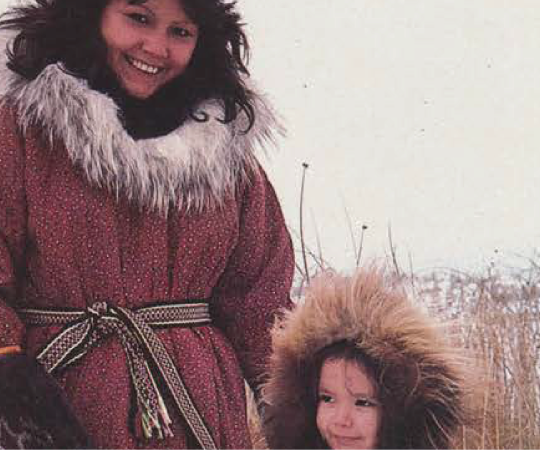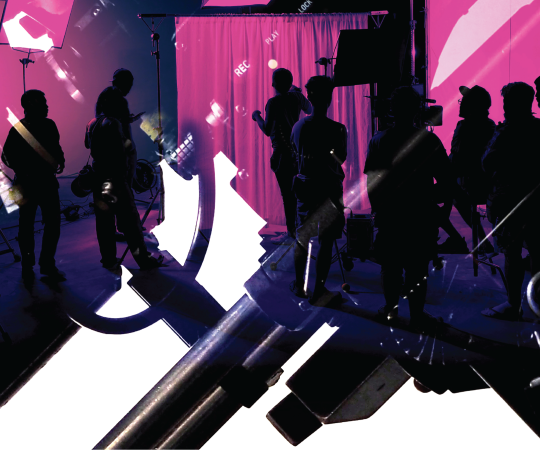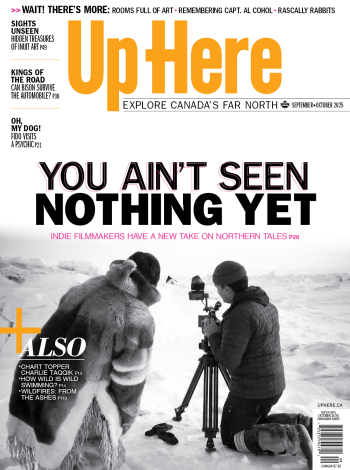There’s a lot that can be said without words.
In fact, take away the capacity for speech, and it’s amazing the tales you can tell. Every gesture becomes dense with meaning. A simple tilt of the head or shrug of the shoulders speaks volumes. The breadth of emotional expression grows deeper. In the world of theatre, the potential to convey the human experience is infinite when performers use their bodies as much as their words.
At least, that’s how theatre-makers Jessica Hickman and Geneviève Doyon see it. For nearly 10 years, the preference to stage plays in unorthodox ways has been their guiding belief as co-artistic directors of Open Pit Theatre—a company in Whitehorse that specializes in melding movement, such as dance or mime, with storytelling.
“That’s kind of what brought us together, the desire to tell Northern stories, create original work, and explore non-traditional ways of creating,” Doyon says of her and Hickman’s partnership. They wanted to carve out a space in the city’s arts scene for theatre that’s “just a little more experimental, a little less linear, and very physical.”
Now, the two are taking this practice to a whole new level: by swapping out words entirely for masks and puppets in their upcoming show, Radio Silence, set to hit Yukon stages in May.
It all started back in 2019. Hickman and Doyon had just wrapped a cross-country tour of Open Pit’s last production—a play based on 60-some interviews with real-life Yukoners titled Busted Up: A Yukon Story—and were on the hunt for a new project. Their only criterion was that it be completely different from anything they’d done before.
“Over the past few years, we’ve been exploring with each of our shows a different way of working,” says Hickman. “So, when we were dreaming up what we wanted our next project to be, I said, ‘You know, we just did verbatim. How about…a wordless mask show based on Yukon content?’”
The idea quickly stuck. Hickman and Doyon brought on the Wonderheads, a Victoria, B.C.-based mask company, as collaborators and mentors. Members of the two companies sat together in a room in Whitehorse, ruminating on what kind of story they could tell and what it could look like. A week later, they emerged with the concept for Radio Silence.
The story is set in the Yukon in the mid-20th century, and centres on twin sisters Poppy and Ruth, who have been estranged since a plane crash killed their bush pilot father 20 years before. Poppy has dealt with her grief by settling down and starting a family, while Ruth has followed in her father’s footsteps and become a pilot. The sisters remain distant from one another—until one day, Ruth’s plane goes down, and Poppy must venture into the bush to find her.
There’s notable excitement in Hickman and Doyon’s voices as they describe the play. In some ways, they say, it’s an ode to the Yukon’s vast wilderness and illustrious aviation history. Poppy and Ruth’s father vaguely resembles pilot Andy Cruickshank, who brought mail drops by air to Dawson City in 1927. The twins spend a lot of time in the backcountry and encounter iconic Northern wildlife such as foxes and caribou.
Factor in full-face masks, life-sized animal puppets, and the way characters move in mime, and that classic imagery becomes imbued with newfound wonder and whimsy.

“We explore themes of aviation, and we explore the themes of nature, but we try to go about it a different way,” Doyon says. “It’s giving the typical Northern landscape a twist.”
Everything about the production has been carefully designed to celebrate and challenge Yukon iconography in equal measure. For instance, painter Rosemary Scanlon and beading artist Vashti Etzel were commissioned to create images of mountains, flowers, and aurora borealis, which are then projected onto sets made from AluShape, a type of shapable cloth. Not only does this give audiences a sense of time and place, but it filters the landscape through an artistic lens and creates what Hickman dubs a “feast for the eyes.”
As for the masks? Those were all crafted from papier-mâché by Kate Braidwood, co-artistic director of the Wonderheads. It’s a lengthy process, taking her anywhere between 30 to 60 hours to make a single mask. (She made three for this production). It also requires a deep understanding of each character and how they operate within the play’s imagined world.
“We talked about Ruth, the pilot, being the more stubborn of the two sisters, and Poppy, maybe a little more nervous and vulnerable,” Braidwood explains. “So, I take that information and try to make sure that the facial expressions and what they look like are capable of conveying those aspects of their character.”
For Hickman and Doyon, the masks admittedly presented a huge learning curve. The women portrayed Ruth and Poppy respectively while workshopping the production last August, and had to adjust to performing in costume.
“It feels like you are under water, because you can hear your breath quite loudly in the mask,” Hickman says. “And you have zero peripheral vision, because you can only see out of these tiny little holes that are directly in front of you.”
Each side of the masks has a different expression. Turned one way there’s a smile; the other, there’s a frown. It’s a clever and useful tool when there’s no dialogue to rely on for conveying emotion, but every scene has been planned out meticulously to ensure the right emotions are coming across.
And while the characters themselves never speak, the show isn’t necessarily quiet. An old-timey radio will crackle occasionally as an announcer, voiced by local comedian Brenda Barnes, provides clues about the time-period and setting through “breaking news updates.” There will also be an original soundscape, built from Yukon singer-songwriter Calla Kinglit’s 2018 album, Dreamer’s Sea.
But let’s get one thing clear—whimsical as it is, Radio Silence is not meant for children. “As soon as you put puppets in a show, everyone thinks that it’s for kids,” Hickman says with a laugh. “Kids will still enjoy it…but we’re talking about grief and the loss of a loved one through tragedy and how that affects us. It’s not just a silly fox who’s singing a song. It’s deeper content that we’re hoping resonates with adults.”
After three years of development, Radio Silence has now been cast with actors from across the country. It premieres mid-May at the Yukon Arts Centre in Whitehorse, then travels to the Klondike Institute of Art and Culture in Dawson City before heading south to Victoria, B.C and—hopefully—other parts of the country.
“I’m curious [to see] how people react,” Doyon says. “The North that we are representing is not necessarily the one that Yukon Tourism shows…it’s about the surrealism and imagination that it can provide.”
With any luck, life will imitate art, and the audience will be left in wordless wonder.










